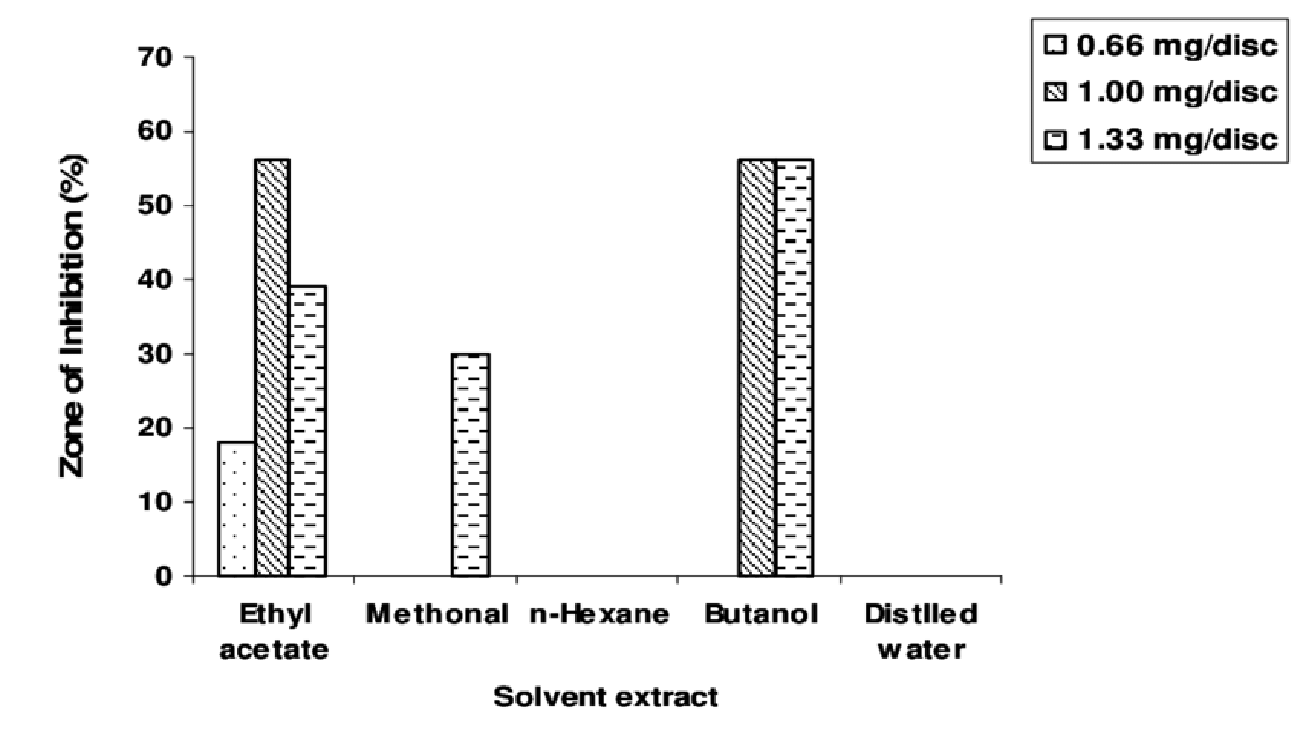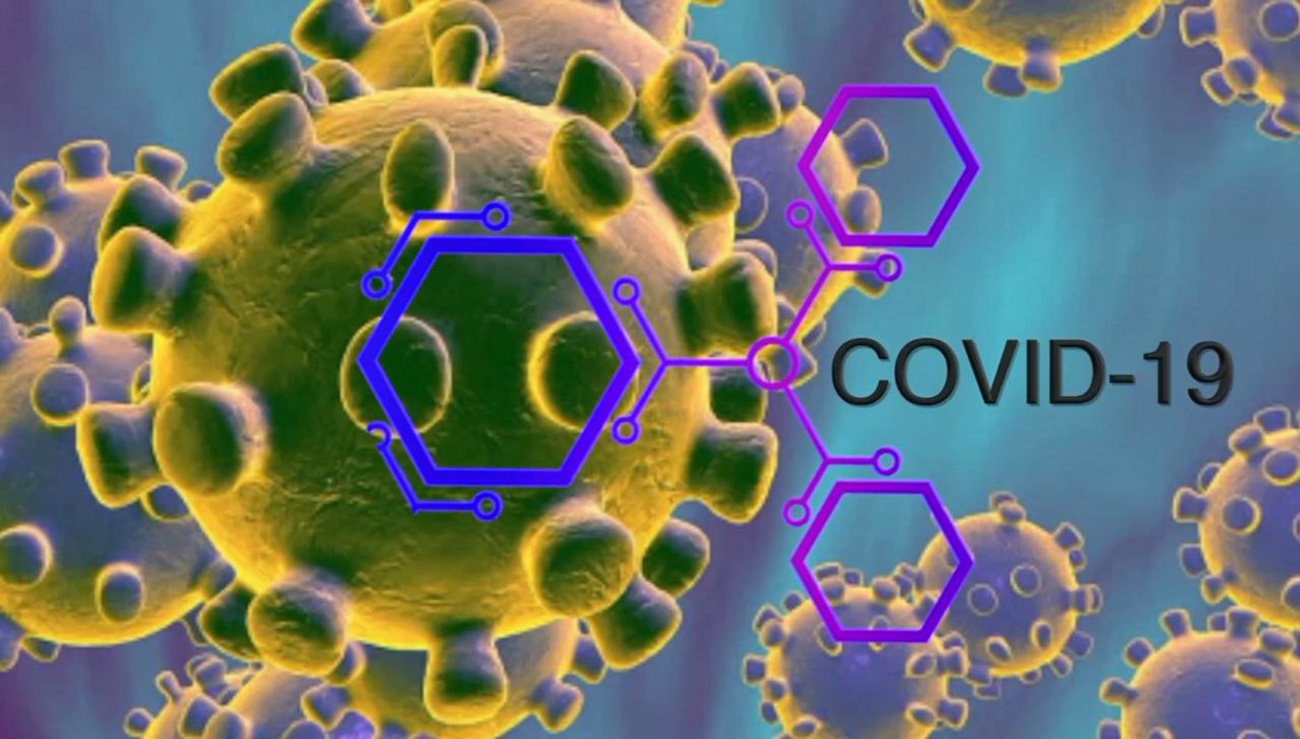
Phytochemical Investigation and Antimicrobial Activity of Hexane, Ethyl Acetate and Methanol Fractions from Stem Bark of Icacina Trichantha Oliv. (Icacinaceae)
Abstract:
Background: Micro-organisms are responsible for the transmission of a large number of diseases. It is hard to comprehend the amount of diseases, deaths and economic losses caused by micro-organisms alone. Plants are good sources of eco-friendly and readily available antimicrobial agents.
Purpose: The aim of this study was to evaluate the chemical constituents and antimicrobial characteristics of three fractions from ethnomedicinal Icacina trichantha. Oliv. (Icacinaceae).
Methods: Methanol extract from Icacina trichantha. Oliv was obtained by maceration and fractionated successively using hexane, and ethyl acetate. The antimicrobial properties of Icacina trichantha. Oliv was assessed using agar cup diffusion method on MRSA, P. aeruginosa, S. typhi, C. krusei, S. dysenteriae, S. pyrogenes, E. coli, K. pneumoniae, C. albicans, and C. tropicalis. Phytochemical screening on fractions was also evaluated using standard methods….
Author(s):
DOI:
https://doi.org/10.15415/jce.2020.71002
Keywords:
Medicinal plants, Icacina trichantha, Icacinaceae, Phytochemicals, Antimicrobials
References:
Adekunle, A.S., & Adekunle, O.C. (2009). Preliminary assessment of antimicrobial properties of aqueous extract of plants against infectious diseases. Biology and Medicine, 1(3), 20–24.
Ajibesin, K.K., Ekpo, B.A., Bala, D.N., Essien, E.E. & Adesanya, S.A. (2008). Ethnobotanical survey of AkwaIbom State of Nigeria. Journal of Ethnopharmacology, 115(3), 387–408. https://doi.org/10.1016/j.jep.2007.10.021
Akinyemi, K.O., Oladapo, O., Okwara, C.E., Ibe, C.C., & Fasure, K.A. (2005). Screening of crude extracts of six medicinal plants used in South West Nigeria unorthodox medicine for anti-methicilin resistant Staphylococus aureus activity. BMS complementary and alternative medicine, 5: 6, 1-7. https://doi.org/10.1186/1472-6882-5-6
Aliero, A.A., Aliero, B.L., & Bulan, U. (2008). Preliminary and antibacterial screening of perspective. Paradign publication Brookline, Massachusetts pp. 7-12.
Ariwaodo, J.O., Chukwuma, E.C., & Adeniji, K.A. (2012). Some medicinal plant species of Asamagbe stream bank vegetation, Forestry Research Institute of Nigeria, Ibadan. Ethnobotany Research and Applications, 10, 541–549.
Asuzu, I.U., & Abubakar, I.I. (1995). The effects of Icacina trichantha tuber extract on the nervous system. Phytotherapy research, 9(1), 21–25. https://doi.org/10.1002/ptr.2650090106
Asuzu, I.U., & Aforonwa, C.U. (1998). The pharmacological effects of Icacina trichantha leaf methanol extract. Journal of Herbs, Spices and Medicinal Plants, 6(1), 49–56. https://doi.org/10.1300/J044v06n01_07
Asuzu, I.U., Sosa, S., & Loggia, R.D. (1999). The antiinflammatory activity of Icacinatrichantha tuber. Phytomedicine, 6, 267–272. https://doi.org/10.1016/S0944-7113(99)80019-1
Burkill, H.M. (1994). The Useful Plants of West Tropical Africa. Kew, U.K.: The Royal Botanical Garden, Ed. 2, Vol. 2, pp. 418–419.
Edori, O.S., & Ekpete, O.A. (2015). Phytochemical screening of aqueous extract of Icacinatrichantha roots and its effect on mortality of wood termite. World Journal of Pharmaceutical Research, 4(10), 213–224.
Elisabetsky, E. (1991). Socio-political, economic and ethical issues in the medicinal plant research. Journal of Ethanopharmacology, 32(1-3), 235-239. https://doi.org/10.1016/0378-8741(91)90124-V
Harborne, J.B. (1973). Phytochemicals Methods. London: Chapman and Hall Ltd., pp. 49-188.
Hassan, S.W., Umar R.A., Ebbo, A.A., and Matazu, I. K. (2005). Phytochemical, antibacterial and toxicity studies of Parkinsonia aculeate L. (Fabaceae). Nigerian Journal of Biochemistry and Molecular Biology, 20(2), 89-97.
Kokate, C.K., Purohit, A.P., & Gokhale, S.B. (2007). Pharmacognosy. Delhi: Nirali Prakashan Delhi, pp. 593-597.
Krishnaiah, D., Dev, T., Bono, A., & Sarbatly, R. (2009). Studies on phytochemical constituents of six Malaysian medicinal plants. Journal of Medicinal Plants Research, 3(2), 67-72.
Mbatchou, V.C., & Dawda, S. (2012). Phytochemical and pharmacological profile of genus Icacina. Phytopharmacology, 2, 135–143.
Ojo, O.O., Tell, I.O., & Ademola, O.O. (2005). Effect of Azadiractha indica, Tamarindus indica and Eucalyptus camaldulensis on paracetamol induced lipid peroxidation in rats. Journal of Sustainable Development Agricultural Environment, 1, 755-760.
Oke, J.M., & Hamburger, M.O. (2002). Screening of some Nigerian medicinal plants for antioxidant activity using 2, 2-diphenyl-picryl-hydrazyl radical. African Journal of Biomedical Research, 5, 77–79.
Okoli, S., & Iroegbu, C.U. (2005). In vitro antibacterial activity of Synclisa scabrida whole root extracts. African Journal of Biotechnology, 4(9), 946-952. https://doi.org/10.5897/AJB2005.000-3192
Otun, K.O., Onikosi, D.B., Ajiboye, A.T., & Jimoh, A.A. (2015). Chemical composition, antioxidant and antimicrobial potentials of Icacinatrichantha Oliv. leaf extracts. Research Journal of Phytochemistry, 9(4), 161–174. https://doi.org/10.3923/rjphyto.2015.161.174
Quattrocchi, U. (2012). Icacina In CRC World Dictionary of Medicinal and Poisonous Plants, Boca Raton, Florida: CRC Press.
Shagal, M.H., & Kubmarawa, D. (2013). Antimicrobial and phytochemical screening of Icacinatrichantha. American Journal of Biomedical and Life Sciences, 1(2), 37–40. https://doi.org/10.11648/j.ajbls.20130102.11
Shagal, M.H., Mukhtar, H., Akinterinwa, A., & Ndahi, J.A. (2014). Phytochemical investigation of methanolic extract of Icacina trichantha tuber. International Journal of Current Microbiology and Applied Sciences, 3(5), 907–911.
Sofowora, A. (1993). Medicinal Plants and Traditional Medicine in Africa. Ibadan, Nigeria: Spectrum Books Ltd., pp. 191-289.
Timothy, O., & Idu, M. (2011). Preliminary phytochemistry and in vitro antimicrobial properties of aqueous and methanol extracts of Icacinatrichantha Oliv. leaf. International Journal of Medicinal and Aromatic Plants, 1, 184–188.
Trease, G.E. & Evans, W.C. (1989). Pharmacognosy.London: Bailliere Tindall, 11th Ed. pp. 45-50.
Ubom, R.M. (2010). Ethnobotany and biodiversityconservation in the Niger Delta, Nigeria. International Journal of Botany, 6(3), 310–322. https://doi.org/10.3923/ijb.2010.310.322
Udeh, N.E., & Nwaehujor, C.O. (2011). Antioxidant and hepatoprotective activities of ethyl acetate leaf extract of Icacinatrichantha on paracetamol-induced liver damage in rats. Continental Journal of Animal and Veterinary Research, 3, 11–15. https://doi.org/10.5281/zenodo.818042
Udofia, S.I., Uluocha, O.B., & Asuquoekpo, C.R. (2014). Evaulation of two indigenous multipurpose shrub species for agroforestry practices in Nigeria. AFRREV STECH: An International Journal of Science and Technology, 3(3), 16–26. https://doi.org/10.4314/stech.v3i3.2
Umoh, E.O., & Iwe, M.O. (2014). Effects of processing on the nutrient composition of false yam (Icacinatrichantha) flour. Nigerian Food Journal, 32(2), 1–7. https://doi.org/10.1016/S0189-7241(15)30111-9
Umoh, E.O. (2013). Anti-nutritional factors of false yam (Icacina trichantha) flour. Internet Journal of food Safety, 15, 78–82.
WHO, (2002). The World health report 2002- Reducing risks, promoting healthy life. Geneva, World Health Organization. Retrieved from https://www.who.int/whr/2002/en/
Yahaya, O., Yabefa, J.A., & Usman, B. (2012). Phytochemical screening and antibacterial activity of Combretumglutinosum extracts against some human pathogens. British Journal of Pharmacology and Toxicology, 3(5), 233-236.
Yesmin, M.N., Uddin, N.S., Sanzida, M., & Muhammad, A.A. (2008). Antioxidant and Scadoxusmaltiflorus. International journal of pure and applied sciences, 2, 13-17.




